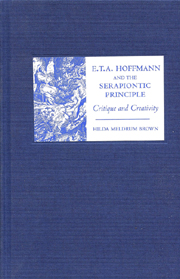Introduction: Approaches to the Serapiontic Principle
Published online by Cambridge University Press: 05 February 2013
Summary
The Serapiontic Principle is a term much bandied about in Hoffmann criticism. However, as a concept or critical tool it has not found wide-spread acclaim nor been deemed to have much application to Hoffmann's literary works, let alone much relevance outside these. Even when it is invoked, there is little agreement about its precise meaning, nor have there been serious attempts to unravel its multifaceted exposition. Some are disposed to deny its importance altogether and complain of muddled presentation on Hoffmann's part; others are skeptical about the meaningfulness of terms such as “inneres” or “wirkliches Schauen.” Few, if any, seem to wish to extend its scope beyond the literary to fields like the visual arts and music. It is my intention in this book to clarify Hoffmann's theory and to show its relevance to a large portion of his creative output. Because for Hoffmann the process of reception is, as we shall see, closely linked to the creative process itself, this scrutiny may produce some new insights into the narrative works and the seriousness of Hoffmann's purpose as a contributor to the Romantic program.
There are good reasons for the neglect and misunderstanding with which the Serapiontic Principle has been received. Hoffmann's was one of the most acute, perceptive, and wide-ranging critical minds of his generation, not only in the realm of prose fiction and narrative but also in that of musical criticism, in which he was a pioneer, writing regular reviews of compositions by the leading composers of the day in the Leipzig Allgemeine Musikalische Zeitung.
- Type
- Chapter
- Information
- E. T. A. Hoffmann and the Serapiontic PrincipleCritique and Creativity, pp. 1 - 18Publisher: Boydell & BrewerPrint publication year: 2006



